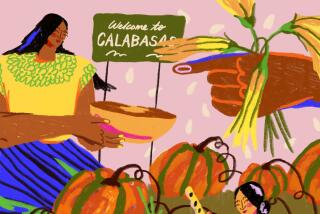Squashing Pumpkins
- Share via
A certain giant squash, called donghua in Chinese, is known as winter melon in this country. A more correct name might be wax gourd, because it’s covered with a whitish substance that can look like a thin film of mud but is actually wax--as you will find if you try to wash it off. Winter melons have so much wax on them that at one time people used to scrape it off and make candles out of it.
The wax is what makes winter melons winter melons, because they can keep, sealed in their wax coating, for six months or a year after being harvested in summer. When the fruits are small, though, they have no wax, just a coating of downy hair, so they’re called hairy melons.
Gourd, squash, melon: What’s the difference? Gourds and squashes are similar, but since “squash” is a New World name, we tend to apply it to American gourds such as pumpkins, zucchini and summer squash. (In England, these all might be called gourds.) But we use “gourd” for Old World squashes, such as bottle gourds, which people in Asia and Africa have long dried out and used as containers.
China is particularly rich in gourds, but to Americans, who didn’t traditionally eat them, the Chinese gourds looked like melons. So that’s what we call them--even the very un-fruitlike one known as bitter melon.
The fact is, there’s no hard and fast line separating squashes (or gourds) from melons. They all belong to the same botanical family, the Cucurbitaceae. The basic rule is that squashes tend to be dry and starchy and used like vegetables (except for the pumpkin), while melons are wet and sweet and eaten raw.
Except for all those Chinese “melons,” of course.

